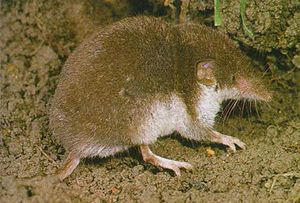Field shrew
| Field shrew | ||||||||||||
|---|---|---|---|---|---|---|---|---|---|---|---|---|

Crocidura leucodon |
||||||||||||
| Systematics | ||||||||||||
|
||||||||||||
| Scientific name | ||||||||||||
| Crocidura leucodon | ||||||||||||
| ( Hermann , 1780) |
The field shrew ( Crocidura leucodon ) is a mammal of the genus white- toothed shrews ( Crocidura ) from the shrew family . It inhabits large parts of Europe and southwest Asia .
Mark
The head-trunk length is 65 to 85 mm, the tail length 28 to 43 mm and the weight 7 to 15 g. The top is brown-gray, the flanks and the bottom are sharply contrasted white-gray.
distribution
The range of the field shrew includes Central and Southeast Europe and Southwest Asia. In a west-east direction the area of the species extends from Brittany to the Caspian Sea , in a north-south direction from Schleswig-Holstein to the southern tip of Italy .
The southwestern limit of distribution runs through central France. In the rest of Europe the distribution is patchy. The species is absent in large parts of north and northwest Germany and the Netherlands , it is also absent in southern Bavaria and in large parts of Austria and the Czech Republic . In Poland it occurs only in the southeast.
habitat
The field shrew inhabits forest-free, extensively used open habitats such as fallow land, abandoned grassland, roadsides, fields and gardens from the plains up to about 700 m height. At certain times of the year the animals move to more covered and more humid terrain. Especially in the area of the northern limit of distribution, the species is closely tied to human settlements; in Poland it is much more common in larger cities than in small towns and villages. In the rest of the species' area, houses are mainly used for wintering.
Way of life
The diet consists mainly of insects and their larvae, harvestmen , spiders , diplopods and snails . Reproduction probably takes place from April to September. The litters include 3 to 10 young. The freshly born young mice weigh about 1.0 g. The eyes open by 7 to 13 days of age; after 40 days the young animals are independent. During their excursions, the young mice form the caravans typical of many eyelash shrews , from the age of 7 days by biting the root of the tail of the front animal, from around the 14th to the 28th day by contact with it.
Existence and endangerment
The field shrew in Germany is listed as “endangered” (category 3) in the Red List due to its close ties to extensively used, open habitats and the endangerment of these habitats due to increased use . However, more recent studies have at least regionally led to a more positive assessment of the endangerment, for example in Bavaria in 2003 the species was classified as harmless. The world population is also considered safe according to the IUCN .
swell
literature
- Anthony J. Mitchell-Jones, Giovanni Amori, Wieslaw Bogdanowicz, Boris Krystufek, PJH Reijnders, Friederike Spitzenberger, Michael Stubbe, Johan BM Thissen, Vladimiŕ Vohralik, Jan Zima: The Atlas of European Mammals. Poyser, London, 1999, ISBN 0-85661-130-1 , pp. 64-65.
- Erwin Stresemann (founder), Konrad Senglaub (ed.): Excursion fauna of Germany. Volume 3: Vertebrates. 12th, heavily edited edition. G. Fischer, Jena et al. 1995, ISBN 3-334-60951-0 , pp. 374-375.
Web links
- Crocidura leucodon in the Red List of Threatened Species of the IUCN 2008. Posted by: Amori, G. (Small Nonvolant Mammal Red List Authority) & Temple, H. (Global Mammal Assessment Team), 2008. Accessed on 24 February, 2009.
Individual evidence
- ↑ Alois Liegl, Bernd-Ulrich Rudolph and Richard Kraft: Red List of Endangered Mammals (Mammalia) Bavaria. Bay LfU 166, 2003 online, (PDF; 74 kB) .
